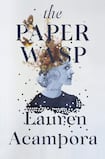
“This orchid grew a dark protuberance that mimicked the appearance of a wasp, luring other wasps into attempts at copulation, thus pollinating the orchid itself.” Lauren Acampora’s gripping debut novel, The Paper Wasp, is a tale of friendship, obsession and identity theft that is likely to buzz its way into many beach bags this summer.
A Ripley-esque novel that loses the plot in the final quarter, it is nonetheless a decent bet for readers looking for a well-written page-turner. Acampora’s previous endeavours are more literary in nature, with her debut collection of linked stories, The Wonder Garden, winning the GLCA New Writers Award. Her short fiction has appeared in publications such as The Paris Review. She was raised in Connecticut and lives in New York with her family, but the action of her novel primarily takes place in Hollywood, Los Angeles.
After an opening scene of an excruciating school reunion, narrator Abby Graven – an insular, damaged small town girl from Michigan – follows her beautiful high-school friend Elise to Hollywood, where the latter is a rising star. The awkwardness of Abby arriving uninvited is beautifully written by Acampora, as is the conniving, convincing way she makes herself indispensable to Elise. Directing the story to her former friend, Abby is creepy and compelling from the outset, an underdog voice that many will root for. Obsessed with Rhizome philosophy (a real-life concept) and its fictional leader, Perren, her interior thoughts are just the right side of delusional: “Over the years, I’d come to realize that I was unlike anyone else. I knew that my visions were attached to something much larger, a giant scaffolding meant only for me, sections of which I could just glimpse, bit by bit, as I climbed.”
Joan Didion accent
Elise, meanwhile, is a smart, believable counterpart who could so easily become an unlikeable prima donna in the wrong hands. She calls out Abby’s compliments as platitudes and spends her time perfecting her Joan Didion accent for her next movie. But as the codependent relationship develops, Abby’s obsessive nature soon sets in: “Suddenly, amazingly, I was your closest confidante. I’d slipped back into your life as if I’d never left, as if we’d somehow awoken from a slumber party as grown women.”
Acampora writes about the subject of female friendship with nuance. Abby’s feelings for her beautiful friend constantly teeter on the brink of sexual, but ultimately turn out as juvenile as a high-school crush: “With your flawless skin and warm hair feathering your shoulder blades, you were thoroughly, outrageously a movie star. It made sense, looking back on your girlhood, how you’d attracted all of us like metal filings. I was weak just looking at you.”
In the soon-to-be-toxic friendship, there are echoes of another debut, Social Creature by Tara Isabella Burton, though Acampora's world is more finely conceived. A fairer comparison is to the English author Lottie Moggach's excellent debut Kiss Me First (2015), with its lonely, oddball narrator and original exploration of identity and female friendship.
Though The Paper Wasp turns highly fictional, and somewhat ludicrous, in the end, the hard truths and insights that are notable in Acampora’s short fiction enliven the journey along the way. Meaty topics underpinning the story – art, ambition, class, power – are thoughtfully explored and an arch eye is cast over life in the Hollywood bubble. “You’re not a regular kombucha drinker?” Elise’s movie star boyfriend (also an Argentine polo player) asks Abby in shock. Elsewhere, an expensive LA style makeover – the basis of so much reality TV – is given short shrift: “You led me along the sidewalk like a rescue dog and drew me into a hair salon, where you sat me in the chair and told the stylist what to do.”
Nonsensical subplot
Where the book falls down is in its subplot involving the Rhizome, and its leader Perren. Initially intriguing (and eerily believable in a town that seems to have a clinic for everything), Abby’s sessions with Rhizome practitioner Telo are too vague and nonsensical to hold our interest. Underdeveloped ideas about children in the Rhizome, a leftfield turn with a documentarian, and a woefully neglected older sister who only appears as a kind of deus ex machina baby maker all contribute to a rushed and unsatisfying end.
The power of the story is in the friendship of the core characters, in the way that both women use each other to make their own lives more palatable. Abby, who wants to make films as opposed to star in them, sees herself as above Elise: “Yours was the lesser role, but a crucial one, and one for which you were perfectly made.” In The Paper Wasp, Acampora writes her world and characters with a sting in the tale, the knowledge that friendship will be sacrificed in the name of personal ambition.











